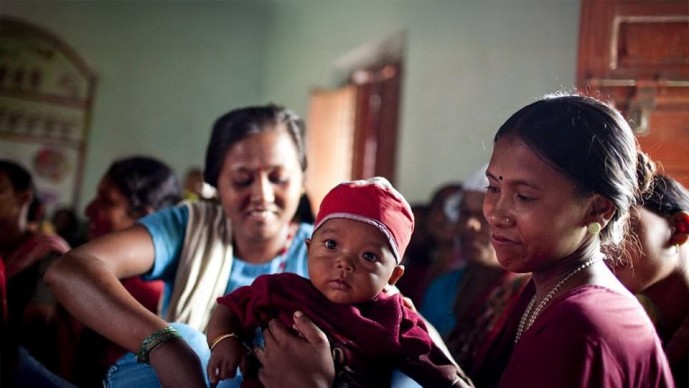Breaking Down the Roadblocks to Saving Lives
- Gary Darmstadt, Wendy Prosser, Andrew Serazin, Jul 13, 2012

I'm sure you have heard of the phenomenon of cell phone technology in Africa - the phone landlines never really got going; the continent just skipped to an extensive cell phone network. Now more than 500 million cell phones are in use, for talking, texting, banking, education, and even text messaging reminders about health care.
Saving Lives at Birth wants to capture and nurture that same energy and innovation of leapfrogging existing solutions and apply it to protecting mothers and newborns in the hardest-to-reach regions at the most critical times.
Today is the second day of the DevelopmentXChange event, in Seattle, WA, for the Saving Lives at Birth initiative. We have a lot of questions; we understand many of the risks related to maternal and newborn health; we even understand many of the causes of the complications.
"Ideally we believe that a truly revolutionary idea incorporates aspects of all three of these dimensions into one solution."
What we don't have are enough solutions that are technically sound and innovative, yet affordable, acceptable, scalable and sustainable.
We have an expanded definition of innovation that takes into account three persistent roadblocks: technologies, service delivery, and demand. Ideally we believe that a truly revolutionary idea incorporates aspects of all three of these dimensions into one solution.
Yesterday we heard from three of the winners from last year about their first year of implementation - the "Aha! Moments", the challenges, the lessons learned, the promising next steps. It is fascinating and inspiring to see the potential of these and all of the Saving Lives at Birth grantees.
- MONASH University is tackling the problem of postpartum hemorrhage. The current solution, oxytocin, is not suited for transportation, storage or administration in resource-poor countries. This grantee is developing a different formulation of oxytocin that can be inhaled and absorbed into the bloodstream and still be effective on the muscles in the uterus. The researchers have to take a lot of things into consideration for this product-the size and shape of the inhaler device, appropriate quantity of oxytocin, regulatory issues, and cultural considerations and acceptability, just to name a few. If the design doesn't match the needs of the people who use it, it's not going to help anybody.
- The Better Cord Care Saves Babies Lives project connects a product with community practices. Dry cord care -leaving the umbilical cord dry, without applying ointments - is typically recommended for newborns. In Nepal, that is what the nurses and midwives even tout. However, cultural practices encourage moms to apply different ointments, oils and other substances that can be harmful to the baby's health and increase the risk for infection. Through community health workers, JSI is educating women on clean cord care and the use of chlorhexidine, which has been proven to drastically reduce the risk of newborn infection. The Nepalese government has adopted this practice as policy, and this Saving Lives at Birth grant allows this project to scale up to national level. After a year of scale-up efforts, the project is demonstrating progress and seeing moms, families, nurses and midwives change their behaviors for safer cord care with chlorhexidine. This project illustrates that success doesn't have to be big to inspire; this small country is demonstrating scalability that can spread through the region and the world.
- Some projects don't feature a new technology or product at all; rather their innovation is in the way they interact with the community. The PROTECT project in Cambodia is addressing one of the biggest challenges to antenatal and postnatal care and institutional births in low resource settings: transportation. Many times roads are bad, vehicles are not available, or the cost of paying for transport is prohibitive. Partners for Development is taking an innovative, community-participative approach to develop and implement a transport system of private sector providers in partnership with local government. Families pay a low monthly rate and are guaranteed transport to the health center for care for pregnant women and institutional birth. The communities have complete ownership of this initiative, developing time schedules, routes, and even recruiting the drivers. The success is notable - health centers have seen an increase in women presenting for care and demand for transport is high. Actually, it's so high that it has presented a different, unexpected challenge: students are using the transport service to get to school and the cars are reaching capacity.
No matter which project was presenting, a couple of common themes emerged.
These innovations are starting and ending in the community: from understanding what inhaler is most appropriate, to knowing about the cord care practices in order to develop a product that is appropriate, to having a clear idea of women's priorities for transport.
We also saw a diverse set of players coming together to tackle these challenges - physical chemists who had never stepped foot in a developing country before mingled with community activists and health workers who face the challenge of a safe delivery without extensive resources every day.
And the common factor among all of them? The motivation and inspiration to save the lives of women and newborns.
You can check out all of the Round One winners from last year at this link. Tomorrow Saving Lives at Birth will announce Round Two winners; new grants with the potential to change technologies used for newborn feeding, or to improve communication technologies used by frontline health workers to enhance care provided during delivery, or new approaches to motivate women and their communities to seek care and adopt healthier behaviors.
Check out all of this year's finalists here. And stay tuned for the announcement of winners this weekend!